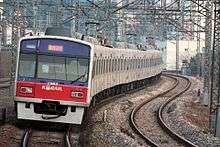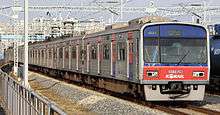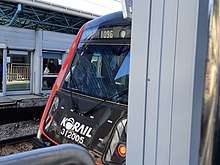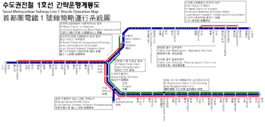Seoul Subway Line 1
Line 1 of the Seoul Metropolitan Subway is a rapid transit and commuter rail line which links central Seoul, South Korea to Soyosan Station in the northeast, Incheon in the southwest, and Sinchang via Suwon and Cheonan in the south. The central underground portion of this rail line is the oldest subway section in the Seoul Metropolitan Subway system. Its branches and services cover a large part of the Seoul Capital Area; totaling 200 km (120 mi) in route length.
| Line 1 | |||
|---|---|---|---|
| Overview | |||
| Native name | 1호선(一號線) Il Hoseon | ||
| Type | Rapid transit / Commuter Rail | ||
| System | Seoul Metropolitan Subway | ||
| Status | Operational | ||
| Termini | Soyosan Incheon / Sinchang / Gwangmyeong / Seodongtan | ||
| Stations | 97 Seoul Metro: 10 Korail: 87 | ||
| Operation | |||
| Opened | August 15, 1974 | ||
| Operator(s) | Seoul Metro & Korail | ||
| Technical | |||
| Line length | 200.6 km (124.6 mi) Seoul Metro: 7.8 km (4.8 mi)[1] Korail: 192.8 km (119.8 mi) | ||
| Track gauge | 1,435 mm (4 ft 8 1⁄2 in) standard gauge | ||
| Electrification | 1,500 V DC, 25 kV AC 60 Hz overhead line | ||
| Operating speed | 110 km/h (68 mph) | ||
| |||
The underground section between Seoul Station and Cheongnyangni Station, which is referred to as Seoul Metro Line 1 (7.8 kilometers [4.8 mi]), is currently operated by Seoul Metro.[1] The line first opened in 1974 as the '''Korean National Railroad of Seoul''' with through services to national mainline railways from Seongbuk Station (now: Kwangwoon University Station) to Incheon and Suwon Stations.[2] At the time, the 7.8 km underground portion was run by Seoul Metro was called Line 1 and labeled red on maps. On the other hand, the remaining sections of the rail line run by Korail were labeled either blue or gray on maps, and the express lines were red. In 2000, the adjacent through-running Korail services from the Gyeongbu, Gyeongin and Gyeongwon Lines were officially bundled together as part of a greater Line 1, and the labeling on maps was changed to the current dark blue color.
Frequent service is provided between Soyosan, Dongducheon, Uijeongbu, Cheongnyangni, Seoul, Yongsan, and Guro, where trains split between Incheon in the west and Byeongjeom and Cheonan in the south. Express trains operate from Yongsan and Seoul Stations to Dongincheon and Sinchang stations. Trains run every 3-6 min in the central route between Seoul Station and Cheongnyangni, every 6-9 min between Seoul and Guro, every 8-10 min between Guro and Incheon and between Guro and Byeongjeom, every 10-15 min from Byeongjeom to Cheonan, and every 35 min between Cheonan and Sinchang and service up to the Dongducheon area and Soyosan station
Trains travel along Gyeongbu (Seoul-Cheonan), Gyeongin (Guro-Incheon), Janghang (Cheonan-Sinchang), and Gyeongwon (Hoegi-Soyosan) railway lines. The line runs on the left-hand side of the track, as opposed to the right-hand side of the track like all other Seoul Metropolitan Subway lines (another exception to this is Seoul Subway Line 4 although it runs on the right-hand side until Namtaeryeong station, and operates on the left-hand side for the parts afterwards)[3] since railways in Korea generally run on the left side.
Rapid (Express) trains
Korail operates a variety of express "rapid" (급행, 急行) trains for long distance commuter services on Line 1. These services include:
- Gyeongin line express services from Yongsan to Dongincheon, operating express between Guro and Dongincheon, including:
- Regular express services, introduced on January 29, 1999, following quadruple-tracking of the Gyeongin Line.
- Faster limited express (특급) trains, introduced on July 7, 2017.
- Red Gyeongbu line express services from Cheongnyangni to Cheonan or Sinchang, operating express between Gasan Digital Complex and Cheonan and running local elsewhere.
- Green Gyeongbu line express service from Seoul Station to Cheonan or Sinchang, originating at a platform adjacent to Seoul Station, skiping all stations between Seoul Station and Geumcheon-gu Office Station, made intermediate stops at Anyang, Gunpo, and Uiwang, and then following the red Gyeongbu express service pattern south of Suwon. Northbound services (departing from Cheonan/Sinchang and terminating at Seoul Station) stop at Yeongdeungpo Station, but southbound services do not due to the lack of a raised platform. This service was introduced on September 25, 1982.[4]
- Gyeongwon line express services from Dongducheon (although several trains originate from Soyosan) to Incheon, operating express between Dongducheon and Kwangwoon University and running local between Incheon and Kwangwoon University.
Former express services include:
- One late night Gyeongin line express service that originated at Soyosan, made all stops to Guro, then made express stops until Incheon.
- Yeongdeungpo-Byeongjeom Gyeongbu line express service, skipping all stations between Yeongdeungpo and Anyang and then following the Yeongsan-Cheonan/Sinchang express service pattern south of Anyang until Byeongjeom. This service was introduced on August 25, 2014 and was discontinued on December 9, 2016.
- Two faster Yongsan-Sinchang limited express trains (one in each direction), introduced in 2013. This train only operated on weekends and holidays. It was discontinued on July 1, 2018.
Stations
| Cheongnyangni – Seoul Station | ||||||||||||||||||||||||||||||||||||||||||||||||||||||||||||||||||||||||||||||||||||||||||||||||||||||||||||||||||||||||||||||||
|---|---|---|---|---|---|---|---|---|---|---|---|---|---|---|---|---|---|---|---|---|---|---|---|---|---|---|---|---|---|---|---|---|---|---|---|---|---|---|---|---|---|---|---|---|---|---|---|---|---|---|---|---|---|---|---|---|---|---|---|---|---|---|---|---|---|---|---|---|---|---|---|---|---|---|---|---|---|---|---|---|---|---|---|---|---|---|---|---|---|---|---|---|---|---|---|---|---|---|---|---|---|---|---|---|---|---|---|---|---|---|---|---|---|---|---|---|---|---|---|---|---|---|---|---|---|---|---|---|
| ||||||||||||||||||||||||||||||||||||||||||||||||||||||||||||||||||||||||||||||||||||||||||||||||||||||||||||||||||||||||||||||||
Main Lines
GW: Gyeongwon Express (Soyosan/Dongducheon - Incheon)
GI: Gyeongin Express (Yongsan – Dongincheon) Express
GB: Gyeongbu Express (Cheongnyangni – Byeongjeom/Cheonan/Sinchang)
Local lines:
- Soyosan/Dongducheon/Yangju <——> Incheon
- Yeongdeungpo <——> Gwangmyeong
- Sinchang/ Cheonan / Seodongtan <——> Kwangwoon University
| ● | Stops at the station |
| | | Does not stop at the station |
| ○ | Limited service |
| F | Future service |
Number |
English |
Hangul |
Hanja |
in km |
Distance |
||||||||
| Soyosan | 소요산 | 逍遙山 | |||||||||||
| Dongducheon | 동두천 | 東豆川 | |||||||||||
| Bosan | 보산 | 保山 | |||||||||||
| Dongducheon Jungang (Shinhan University Campus 2) |
동두천중앙 | 東豆川中央 | |||||||||||
| Jihaeng | 지행 | 紙杏 | |||||||||||
| Deokjeong (Seojeong College) |
덕정 | 德亭 | |||||||||||
| Deokgye | 덕계 | 德溪 | |||||||||||
| Yangju | 양주 | 楊州 | |||||||||||
| Nogyang | 녹양 | 綠揚 | |||||||||||
| Ganeung | 가능 | 佳陵 | |||||||||||
| Uijeongbu | 의정부 | 議政府 | |||||||||||
| Hoeryong | 회룡 | 回龍 | U | ||||||||||
| Mangwolsa (Shinhan Univ.) |
망월사 | 望月寺 | |||||||||||
| Dobongsan | 도봉산 | 道峰山 | |||||||||||
| Dobong | 도봉 | 道峰 | |||||||||||
| Banghak (Dobong-gu Office) |
방학 | 放鶴 | |||||||||||
| Chang-dong | 창동 | 倉洞 | |||||||||||
| Nokcheon | 녹천 | 鹿川 | |||||||||||
| Wolgye (Induk Univ.) |
월계 | 月溪 | |||||||||||
| Kwangwoon Univ. | 광운대 | 光云大 | Gyeongchun | ||||||||||
| Seokgye | 석계 | 石溪 | |||||||||||
| Sinimun (Korea Nat'l Univ. of Arts) |
신이문 | 新里門 | |||||||||||
| Hankuk Univ. of Foreign Studies | 외대앞 | 外大앞 | |||||||||||
| Hoegi | 회기 | 回基 | Gyeongui–Jungang Gyeongchun | ||||||||||
| Cheongnyangni (Univ. of Seoul) |
청량리 | 淸凉里 | Gyeongui–Jungang Gyeongchun Bundang |
||||||||||
| Jegidong (Korea Association of Health Promotion) |
제기동 | 祭基洞 | |||||||||||
| Sinseol-dong | 신설동 | 新設洞 | |||||||||||
| Dongmyo | 동묘앞 | 東廟앞 | |||||||||||
| Dongdaemun | 동대문 | 東大門 | |||||||||||
| Jongno 5(o)-ga | 종로5가 | 鍾路5街 | |||||||||||
| Jongno 3(sam)-ga | 종로3가 | 鍾路3街 | |||||||||||
| Jonggak (Standard Chartered Bank Korea) |
종각 | 鐘閣 | |||||||||||
| City Hall | 시청 | 市廳 | |||||||||||
| Seoul station | 서울역 | 서울驛 | |||||||||||
| Namyeong | 남영 | 南營 | |||||||||||
| Yongsan | 용산 | 龍山 | Gyeongui–Jungang |
||||||||||
| Noryangjin | 노량진 | 鷺梁津 | |||||||||||
| Daebang | 대방 | 大方 | Sillim Line (2022) | ||||||||||
| Singil | 신길 | 新吉 | |||||||||||
| Yeongdeungpo | 영등포 | 永登浦 | |||||||||||
| Sindorim | 신도림 | 新道林 | |||||||||||
| Guro | 구로 | 九老 | |||||||||||
| Guil | 구일 | 九一 | |||||||||||
| Gaebong | 개봉 | 開峰 | |||||||||||
| Oryu-dong | 오류동 | 梧柳洞 | |||||||||||
| Onsu | 온수 | 溫水 | |||||||||||
| Yeokgok | 역곡 | 驛谷 | |||||||||||
| Sosa | 소사 | 素砂 | Seohae | ||||||||||
| Bucheon | 부천 | 富川 | |||||||||||
| Jung-dong | 중동 | 中洞 | |||||||||||
| Songnae | 송내 | 松內 | |||||||||||
| Bugae | 부개 | 富開 | |||||||||||
| Bupyeong | 부평 | 富平 | Incheon 1 | ||||||||||
| Baegun | 백운 | 白雲 | |||||||||||
| Dongam | 동암 | 銅岩 | |||||||||||
| Ganseok | 간석 | 間石 | |||||||||||
| Juan | 주안 | 朱安 | Incheon 2 | ||||||||||
| Dohwa | 도화 | 道禾 | |||||||||||
| Jemulpo | 제물포 | 濟物浦 | |||||||||||
| Dowon | 도원 | 桃源 | |||||||||||
| Dongincheon | 동인천 | 東仁川 | |||||||||||
| Incheon | 인천 | 仁川 | Suin | ||||||||||
| Guro | 구로 | 九老 | |||||||||||
| Gasan Digital Complex | 가산디지털단지 | 加山디지털團地 | |||||||||||
| Doksan | 독산 | 禿山 | |||||||||||
| Geumcheon-gu Office | 금천구청 | 衿川區廳 | |||||||||||
| Seoksu | 석수 | 石水 | |||||||||||
| Gwanak | 관악 | 冠岳 | |||||||||||
| Anyang | 안양 | 安養 | Nuriro (limited service) |
||||||||||
| Myeonghak | 명학 | 鳴鶴 | |||||||||||
| Geumjeong | 금정 | 衿井 | |||||||||||
| Gunpo | 군포 | 軍浦 | |||||||||||
| Dangjeong | 당정 | 堂井 | |||||||||||
| Uiwang | 의왕 | 義王 | |||||||||||
| Sungkyunkwan Univ. | 성균관대 | 成均館大 | |||||||||||
| Hwaseo | 화서 | 華西 | |||||||||||
| Suwon | 수원 | 水原 | Bundang |
||||||||||
| Seryu | 세류 | 細柳 | |||||||||||
| Byeongjeom | 병점 | 餅店 | |||||||||||
| Sema | 세마 | 洗馬 | |||||||||||
| Osan College | 오산대 | 烏山大 | |||||||||||
| Osan | 오산 | 烏山 | |||||||||||
| Jinwi | 진위 | 振威 | |||||||||||
| Songtan | 송탄 | 松炭 | |||||||||||
| Seojeong-ri | 서정리 | 西井里 | |||||||||||
| Jije | 지제 | 芝制 | |||||||||||
| Pyeongtaek | 평택 | 平澤 | |||||||||||
| Seonghwan | 성환 | 成歡 | Nuriro (limited service) |
nam-do |
|||||||||
| Jiksan | 직산 | 稷山 | |||||||||||
| Dujeong | 두정 | 斗井 | |||||||||||
| Cheonan | 천안 | 天安 | |||||||||||
| Bongmyeong | 봉명 | 鳳鳴 | |||||||||||
| Ssangyong | 쌍용 | 雙龍 | |||||||||||
| Asan | 아산 | 牙山 | |||||||||||
| Tangjeong (April 2021) | 탕정 | ||||||||||||
| Baebang | 배방 | 排芳 | |||||||||||
| Onyangoncheon | 온양온천 | 溫陽溫泉 | |||||||||||
| Sinchang | 신창 | 新昌 | |||||||||||
Yeongdeungpo – Gwangmyeong shuttle service
Number |
English |
Hangul |
Hanja |
in km |
Distance |
||||
| Geumcheon-gu Office | 금천구청 | 衿川區廳 | |||||||
| Gwangmyeong | 광명 | 光明 | |||||||
Historical Timeline

1974
- August 15: Line 1 is officially opened with 9 stations from Seoul to Cheongnyangni (7.8 kilometers (4.8 mi)),[1] creating a system of 28 stations (excluding the 9 metro stations) on national railroads from Seongbuk Station (now: Kwangwoon University Station, the then-northern terminus) to Incheon Station and Suwon Station. Korail is named Korean National Railroad, with Line 1 just referring to the Seoul–Cheongnyangni section.
1978
- December 9: The Gyeongwon Line from Yongsan to Seongbuk opens as a new branch, with Ichon and Seongsu (now part of the Jungang Line).
1979
- February 1: Yuljeon Station is opened.
1980
- January 5: Sinimun Station is opened.
- April 1: Seobinggo, Hannam and Hoegi (now part of the Jungang Line) are opened.
- July 10: Seongsu is renamed Eungbong Station
1982
- August 2: Seoksu Station is opened.
1984
- January 1: Yuljeon Station is renamed Seongdae-ap Station.
- May 22: Sindorim Station is opened.
- November 20: Baegun Station is opened.
1985
- January 14: Seokgye Station is opened.
- April 20: Chang-dong is opened as a northward extension.
- August 22: Wolgye and Nokcheon are opened.
- October 18: Oksu Station (now part of the Jungang Line) is opened.
1986
- September 2: 6 stations from Uijeongbu to Chang-dong are opened as a northward extension.
1987
- October 5: Uijeongbu Bukbu Station is opened.
- December 31: Jung-dong Station is opened.
1988
- January 16: Onsu Station is opened.
- October 25: The Ansan Line is opened as a southward branch, from Geumjeong Station to Ansan Station.
1994
- July 11: Ganseok and Dowon are opened.
- December 1: Seongdae-ap Station is renamed to Sungkyunkwan University.
1995
- February 16: Guil Station is opened.
1996
- January 1: Hwigyeong Station is renamed to Hankuk University of Foreign Studies Station
- March 28: Bugae Station is opened.
1997
- April 30: Sosa Station is opened.
1998
- January 7: Singil and Doksan are opened.
2000
- Korea National Railroad and Line 1 are integrated as Seoul (Metropolitan) Subway Line 1.
2001
- November 30: Dohwa Station is opened.
2003
- April 30: Seryu and Byeongjeom are opened as a southward extension. The Ansan Line service is replaced with an extended Seoul Subway Line 4.
2004
- August 25: Bugok Station is renamed Uiwang Station.
2005
- January 20: 8 stations from Byeongjeom to Cheonan are opened as another southward extension.
- December 16: The Gyeongwon Line branch from Yongsan Station to Hoegi Station and the Jungang Line from Hoegi Station to Deokso Station open and are renamed to the separate Yongsan-Deokso Line. This service was the predecessor to the current Jungang Line.
- December 21: Dongmyo Station is opened.
- December 27: Sema and Osan College Stations are opened.
2006
- June 30: Jinwi and Jije Stations are opened.
- July 1: Garibong Station is renamed to Gasan Digital Complex.
- December 15: 8 stations from Soyosan to Uijeongbu Bukbu are opened as a northward extension. A spur line to Gwangmyeong Station is created. Uijeongbu Bukbu Station is renamed to Ganeung.
2007
- December 28: Deokgye Station is opened.
2008
- December: 6 stations from Cheonan to Sinchang are opened as another southward extension. Siheung Station is renamed to Geumcheon-gu Office.
2010
- January 21: Dangjeong Station is opened.
- February 26: Seodongtan Station is opened.
2015
- February 3: Gyeongin Line express trains start stopping at Gaebong and Jemulpo stations.
2017
- July 6: A new limited express service was launched between Yongsan and Dongincheon stations.
2019
- December 30: All Gyeongbu Line express trains start stopping at Geumjeong and Sungkyunkwan University stations and are extended to Cheongnyangni. Gyeongbu Line express trains no longer stop at Gunpo station.
Future Plans
Line 1 will be extended northward from Soyosan Station to Yeoncheon Station on the Gyeongwon Line, replacing the current "'Tonggeun" service operating there. Construction on this extension began in September 2014 and is expected to be completed in November 2021.
Rolling stock
Current
Seoul Metro
- Seoul Metro 1000 series
- Rheostat-controlled electric car (rebuilt cars) – since 1989
- VVVF inverter-controlled electric car – since 1999
 Seoul Metro 1000 series rheostat-controlled EMU (2nd batch)
Seoul Metro 1000 series rheostat-controlled EMU (2nd batch) Seoul Metro 1000 series VVVF inverter-controlled EMU
Seoul Metro 1000 series VVVF inverter-controlled EMU
Korail
- Korail Class 1000 (3rd batch) (since 1994)
- Korail Class 311000 (since 1996)
- Korail Class 319000 (for Gwangmyeong Shuttle) (since 2006)
 3rd batch train 1-83 leaving Singil Station
3rd batch train 1-83 leaving Singil Station Korail Class 311000 (1st batch)
Korail Class 311000 (1st batch)- Korail Class 311000 (2nd batch)
 Korail Class 311000 (6th batch)
Korail Class 311000 (6th batch) Korail Class 312000
Korail Class 312000 Korail Class 319000
Korail Class 319000
Former
Seoul Metro
- Seoul Metro 1000 series
- Rheostat-controlled electric car (1st batch) (from 1974 until 2002)
 Seoul Metro 1000 series (1st batch car) on Gyeongbu Line, October 1988
Seoul Metro 1000 series (1st batch car) on Gyeongbu Line, October 1988
Korail
- Korail Class 1000 (1st batch) (from 1974 until 2004)
- Korail Class 1000 (2nd batch) (from 1988 until 2019)
 Preserved Korail Class 1000 (1st batch car), January 2009
Preserved Korail Class 1000 (1st batch car), January 2009 Korail Class 1000 (2nd batch) in new livery
Korail Class 1000 (2nd batch) in new livery
Depots and facilities
(from north to south)
- Majeon signal box between Deokye and Yangju Stations
- Chang-dong Depot (shared with Line 4)
- Seongbuk Depot
- Imun Depot
- Guro Depot
- Siheung Depot (actually after Oido Station on Line 4, also used for heavy maintenance of Line 1 trains owned by Korail, accessed by a crossover located after Geumjeong Station)
- Byeongjeom Depot
See also
- Subways in South Korea
- Seoul Metropolitan Subway
- S-train
References
| Wikimedia Commons has media related to Seoul Subway Line 1. |
- 지하철건설현황 [Status of Subway Construction] (in Korean). Seoul City Government. Retrieved 2014-02-22.
- "Seoul's first subway line opened in 1974". Korea Times. 2011-02-13. Retrieved 2014-07-25.
- (in Korean) <오후여담>좌측통행, Munhwailbo
- https://newslibrary.naver.com/viewer/index.nhn?articleId=1982101400209210002&editNo=2&printCount=1&publishDate=1982-10-14&officeId=00020&pageNo=10&printNo=18778&publishType=00020M

.svg.png)